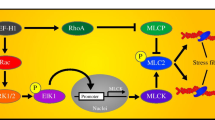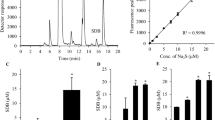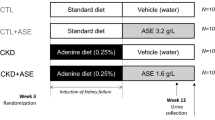Abstract
Organosulfur compounds (OSCs) of garlic have various health benefits including anti-hypertensive effect. It has been described that volatile OSCs uptake occurs into a moderate extent. Among the bioavailable OSCs present in garlic, 2-vinyl-4H-1,3-dithiin (2VD) is a main component in garlic macerated oil and stir-fried garlic but has been poorly investigated compared with others OSCs, such allyl mercaptan (AM) and S-allyl cysteine (SAC). The aim of this study was to evaluate the effects of 2VD on vascular smooth muscle cells (VSMCs) isolated from spontaneous hypertensive rats (SHR) and compare them with those produced by AM and SAC. Cell viability and proliferation were measured using tetrazolium dye MTT assay and flow cytometry. Cell migration was evaluated by scrape-wound migration assay. OSCs anti-oxidative capacity was determined by measuring reactive oxygen species (ROS) generation, and total antioxidant status (TAS). Non-toxic plasmatic concentrations (10 μg L−1) of 2VD and AM inhibited VSMCs proliferation stimulated with 5% fetal bovine serum and impaired cell migration. In further flow cytometry analysis 2VD treatment resulted in a partial cell cycle arrest at G2 phase. The OSCs tested were able to prevent ROS increase after angiotensin II stimulation and surprisingly 2VD induced higher total antioxidant status compared with AM and SAC. Our results showed that 2VD produces equivalent or superior beneficial effects on VSMCs to those reported for other bioavailable compounds of garlic. This preliminary evidence suggests that 2VD intake could also exert important protective effects against arterial remodeling in hypertension.






Similar content being viewed by others
Abbreviations
- AM:
-
Allyl mercaptan
- AngII:
-
Angiotensin II
- CVDs:
-
Cardiovascular diseases
- DMSO:
-
Dimethyl sulfoxide
- FBS:
-
Fetal bovine serum
- OSCs:
-
Organosulfur compounds
- PBS:
-
Phosphate buffered saline
- ROS:
-
Reactive oxygen species
- SAC:
-
S-allyl cysteine
- SHR:
-
Spontaneous hypertensive rats
- TAS:
-
Total antioxidant status
- VSMCs:
-
Vascular smooth muscle cells
- 2VD:
-
2-vinyl-4H-1,3-dithiin
References
Cena H, Calder PC (2020) Defining a healthy diet: evidence for the role of contemporary dietary patterns in health and disease. Nutrients 12(2). https://doi.org/10.3390/nu12020334
Cicero AF, Colletti A (2016) Role of phytochemicals in the management of metabolic syndrome. Phytomedicine 23(11):1134–1144. https://doi.org/10.1016/j.phymed.2015.11.009
Quesada I, de Paola M, Torres-Palazzolo C, Camargo A, Ferder L, Manucha W, Castro C (2020) Effect of Garlic's active constituents in inflammation, obesity and cardiovascular disease. Curr Hypertens Rep 22(1):6. https://doi.org/10.1007/s11906-019-1009-9
Alali FQ, El-Elimat T, Khalid L, Hudaib R, Al-Shehabi TS, Eid AH (2017) Garlic for cardiovascular disease: prevention or treatment? Curr Pharm Des 23(7):1028–1041. https://doi.org/10.2174/1381612822666161010124530
Schwingshackl L, Missbach B, Hoffmann G (2016) An umbrella review of garlic intake and risk of cardiovascular disease. Phytomedicine 23(11):1127–1133. https://doi.org/10.1016/j.phymed.2015.10.015
Locatelli DA, Altamirano JC, González RE, CamargoA B (2015) Home-cooked garlic remains a healthy food. J Funct Foods 16:1–8. https://doi.org/10.1016/j.jff.2015.04.012
Milito A, Brancaccio M, D'Argenio G, Castellano I (2019) Natural sulfur-containing compounds: an alternative therapeutic strategy against liver fibrosis. Cells 8(11): E1356. https://doi.org/10.3390/cells8111356
Shang A, Cao SY, Xu XY, Gan RY, Tang GY, Corke H, Mavumengwana V, Li HB (2019) Bioactive compounds and biological functions of garlic (Allium sativum L.) foods 8(7):246. https://doi.org/10.3390/foods8070246
Ramírez DA, Locatelli D, González RE, Cavagnaro PF, Camargo AB. (2017) Analytical methods for bioactive sulfur compounds in Allium: an integrated review and future directions. J Food Compos Anal 61:4–19. https://doi.org/10.1016/j.jfca.2016.09.012
Torres-Palazzolo C, Ramírez D, Locatelli DA, Manucha W, Castro C, Camargo A (2018) Bioaccessibility and permeability of bioactive compounds in raw and cooked garlic. J Food Compos Anal 70:49–53. https://doi.org/10.1016/j.jfca.2018.03.008
Egen-Schwind C, Eckard R, Jekat FW, Winterhoff H (1992) Pharmacokinetics of vinyldithiins, transformation products of allicin. Planta Med 58(1):8–13. https://doi.org/10.1055/s-2006-961379
Locatelli DA, Nazareno MA, Fusari CM, Camargo AB (2017) Cooked garlic and antioxidant activity: correlation with organosulfur compound composition. Food Chem 220:219–224. https://doi.org/10.1016/j.foodchem.2016.10.001
González R, Vidoni M, Locatelli D, Camargo A (2017) Quality evaluation and discrimination of flavouring process of garlic-flavoured vegetable oils. Int J Food Prop 20(sup1):S1016–S1024. https://doi.org/10.1080/10942912.2017.1326055
Yoo DY, Kim W, Nam SM, Yoo M, Lee S, Yoon YS, Won MH, Hwang IK, Choi JH (2014) Neuroprotective effects of Z-ajoene, an organosulfur compound derived from oil-macerated garlic, in the gerbil hippocampal CA1 region after transient forebrain ischemia. Food Chem Toxicol 72:1–7. https://doi.org/10.1016/j.fct.2014.06.023
Yamada N, Hattori A, Nishikawa T, Fukuda H, Fujino T (2006) Prophylactic effects of ajoene on cerebral injury in stroke-prone spontaneously hypertensive rats (SHRSP). Biol Pharm Bull 29(4):619–622. https://doi.org/10.1248/bpb.29.619
Ramirez DA, Locatelli DA, Torres-Palazzolo CA, Altamirano JC, Camargo AB (2017) Development of garlic bioactive compounds analytical methodology based on liquid phase microextraction using response surface design. Implications for dual analysis: cooked and biological fluids samples. Food Chem 215:493–500. https://doi.org/10.1016/j.foodchem.2016.07.170
Holst B, Williamson G (2008) Nutrients and phytochemicals: from bioavailability to bioefficacy beyond antioxidants. Curr Opin Biotechnol 19(2):73–82. https://doi.org/10.1016/j.copbio.2008.03.003
Shouk R, Abdou A, Shetty K, Sarkar D, Eid AH (2014) Mechanisms underlying the antihypertensive effects of garlic bioactives. Nutr Res 34(2):106–115. https://doi.org/10.1016/j.nutres.2013.12.005
Keophiphath M, Priem F, Jacquemond-Collet I, Clement K, Lacasa D (2009) 1,2-vinyldithiin from garlic inhibits differentiation and inflammation of human preadipocytes. J Nutr 139(11):2055–2060. https://doi.org/10.3945/jn.109.105452
Iciek M, Kwiecien I, Wlodek L (2009) Biological properties of garlic and garlic-derived organosulfur compounds. Environ Mol Mutagen 50(3):247–265. https://doi.org/10.1002/em.20474
Choi YH (2017) Diallyl trisulfide induces apoptosis and mitotic arrest in AGS human gastric carcinoma cells through reactive oxygen species-mediated activation of AMP-activated protein kinase. Biomed Pharmacother 94:63–71. https://doi.org/10.1016/j.biopha.2017.07.055
Horev-Azaria L, Eliav S, Izigov N, Pri-Chen S, Mirelman D, Miron T, Rabinkov A, Wilchek M, Jacob-Hirsch J, Amariglio N, Savion N (2009) Allicin up-regulates cellular glutathione level in vascular endothelial cells. Eur J Nutr 48(2):67–74. https://doi.org/10.1007/s00394-008-0762-3
Castro C, Lorenzo AG, Gonzalez A, Cruzado M (2010) Garlic components inhibit angiotensin II-induced cell-cycle progression and migration: involvement of cell-cycle inhibitor p27(Kip1) and mitogen-activated protein kinase. Mol Nutr Food Res 54(6):781–787. https://doi.org/10.1002/mnfr.200900108
Frismantiene A, Philippova M, Erne P, Resink TJ (2018) Smooth muscle cell-driven vascular diseases and molecular mechanisms of VSMC plasticity. Cell Signal 52:48–64. https://doi.org/10.1016/j.cellsig.2018.08.019
Yi L, Su Q (2013) Molecular mechanisms for the anti-cancer effects of diallyl disulfide. Food Chem Toxicol 57:362–370. https://doi.org/10.1016/j.fct.2013.04.001
Halliwell B (2013) The antioxidant paradox: less paradoxical now? Br J Clin Pharmacol 75(3):637–644. https://doi.org/10.1111/j.1365-2125.2012.04272.x
Castellano I, Di Tomo P, Di Pietro N, Mandatori D, Pipino C, Formoso G, Napolitano A, Palumbo A, Pandolfi A (2018) Anti-inflammatory activity of marine Ovothiol a in an in vitro model of endothelial dysfunction induced by hyperglycemia. Oxid Med Cell Longev 2018:2087373–2087312. https://doi.org/10.1155/2018/2087373
Montezano AC, Nguyen Dinh Cat A, Rios FJ, Touyz RM (2014) Angiotensin II and vascular injury. Curr Hypertens Rep 16(6):431. https://doi.org/10.1007/s11906-014-0431-2
Rattan SIS, Kyriazis M (2019) The science of hormesis in health and longevity. Academic Press, London. https://doi.org/10.1016/C2017-0-00519-0
Author information
Authors and Affiliations
Corresponding author
Ethics declarations
Conflict of Interest
The authors declare that they have no conflict of interest.
Additional information
Publisher’s Note
Springer Nature remains neutral with regard to jurisdictional claims in published maps and institutional affiliations.
Rights and permissions
About this article
Cite this article
Torres-Palazzolo, C., de Paola, M., Quesada, I. et al. 2-Vinyl-4H-1,3-Dithiin, a Bioavailable Compound from Garlic, Inhibits Vascular Smooth Muscle Cells Proliferation and Migration by Reducing Oxidative Stress. Plant Foods Hum Nutr 75, 355–361 (2020). https://doi.org/10.1007/s11130-020-00819-x
Published:
Issue Date:
DOI: https://doi.org/10.1007/s11130-020-00819-x




